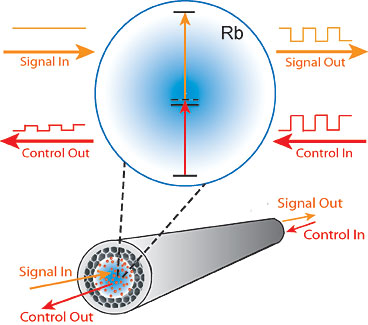Home > Press > Switching light on and off -- with just a few photons at a time
 |
| Gaeta Group Rubidium atoms will absorb photons only if two photons of specific wavelengths arrive at the same time. This allows one stream of photons to turn another on or off. |
Abstract:
Cornell researchers have demonstrated that the passage of a light beam through an optical fiber can be controlled by just a few photons of another light beam.
Switching light on and off -- with just a few photons at a time
Ithaca, NY | Posted on November 9th, 2011Such all-optical control is the idea behind photonics, where beams of light replace electric currents in circuits, yielding higher speed and lower power consumption. Just as a transistor can switch an electric current on or off, photonic circuits need a way for one light beam to switch another. One of the holy grails is single-photon switching, where just one photon controls the passage of another.
Researchers in the Quantum and Nonlinear Optics group of Alexander Gaeta, professor of applied and engineering physics, have come close to that goal. They report their new approach in the Nov. 4 issue of the journal Physical Review Letters.
Light consists of small packets of energy called photons. Under the right conditions, a photon can be absorbed by an atom. Gaeta's group exploited the unusual property of the element rubidium, which can absorb photons only if two photons of certain wavelengths arrive at the same time. They filled a hollow-core optical fiber with rubidium vapor and fired a continuous infrared light signal at a wavelength of 776 nanometers (nm) in one end and an intermittent "control" signal at 780.2 nm in the other.
In the narrow tube, light interacts strongly with the rubidium atoms. When the control beam is on, rubidium atoms absorb both wavelengths, and the signal is cut off; when the control is off the signal passes through.
The effect is observed with less than 20 control photons at timescales as fast as five-billionths of a second, allowing modulation at frequencies up to 50MHz, the researchers said, referring to the rate of transmission of on and off pulses of light representing digital ones and zeroes in fiber-optic communication. The technique also may have applications in quantum computing, where single photons can act as "qubits," the quantum equivalent of ones and zeroes.
The research was funded by the National Science Foundation and the Defense Advanced Research Projects Agency.
==
Graduate student Vivek Venkataraman is a writer intern for the Cornell Chronicle.
####
For more information, please click here
Contacts:
Media Contact:
Blaine Friedlander
(607) 254-8093
Cornell Chronicle:
Bill Steele
(607) 255-7164
Vivek Venkataraman
Copyright © Cornell University
If you have a comment, please Contact us.Issuers of news releases, not 7th Wave, Inc. or Nanotechnology Now, are solely responsible for the accuracy of the content.
| Related News Press |
News and information
![]() Researchers develop molecular qubits that communicate at telecom frequencies October 3rd, 2025
Researchers develop molecular qubits that communicate at telecom frequencies October 3rd, 2025
![]() Next-generation quantum communication October 3rd, 2025
Next-generation quantum communication October 3rd, 2025
![]() "Nanoreactor" cage uses visible light for catalytic and ultra-selective cross-cycloadditions October 3rd, 2025
"Nanoreactor" cage uses visible light for catalytic and ultra-selective cross-cycloadditions October 3rd, 2025
Optical computing/Photonic computing
![]() ICFO researchers overcome long-standing bottleneck in single photon detection with twisted 2D materials August 8th, 2025
ICFO researchers overcome long-standing bottleneck in single photon detection with twisted 2D materials August 8th, 2025
![]() Programmable electron-induced color router array May 14th, 2025
Programmable electron-induced color router array May 14th, 2025
![]() Nanophotonic platform boosts efficiency of nonlinear-optical quantum teleportation April 25th, 2025
Nanophotonic platform boosts efficiency of nonlinear-optical quantum teleportation April 25th, 2025
![]() Groundbreaking research unveils unified theory for optical singularities in photonic microstructures December 13th, 2024
Groundbreaking research unveils unified theory for optical singularities in photonic microstructures December 13th, 2024
Discoveries
![]() Researchers develop molecular qubits that communicate at telecom frequencies October 3rd, 2025
Researchers develop molecular qubits that communicate at telecom frequencies October 3rd, 2025
![]() Next-generation quantum communication October 3rd, 2025
Next-generation quantum communication October 3rd, 2025
![]() "Nanoreactor" cage uses visible light for catalytic and ultra-selective cross-cycloadditions October 3rd, 2025
"Nanoreactor" cage uses visible light for catalytic and ultra-selective cross-cycloadditions October 3rd, 2025
Announcements
![]() Rice membrane extracts lithium from brines with greater speed, less waste October 3rd, 2025
Rice membrane extracts lithium from brines with greater speed, less waste October 3rd, 2025
![]() Researchers develop molecular qubits that communicate at telecom frequencies October 3rd, 2025
Researchers develop molecular qubits that communicate at telecom frequencies October 3rd, 2025
![]() Next-generation quantum communication October 3rd, 2025
Next-generation quantum communication October 3rd, 2025
![]() "Nanoreactor" cage uses visible light for catalytic and ultra-selective cross-cycloadditions October 3rd, 2025
"Nanoreactor" cage uses visible light for catalytic and ultra-selective cross-cycloadditions October 3rd, 2025
Photonics/Optics/Lasers
![]() ICFO researchers overcome long-standing bottleneck in single photon detection with twisted 2D materials August 8th, 2025
ICFO researchers overcome long-standing bottleneck in single photon detection with twisted 2D materials August 8th, 2025
![]() Institute for Nanoscience hosts annual proposal planning meeting May 16th, 2025
Institute for Nanoscience hosts annual proposal planning meeting May 16th, 2025
|
|
||
|
|
||
| The latest news from around the world, FREE | ||
|
|
||
|
|
||
| Premium Products | ||
|
|
||
|
Only the news you want to read!
Learn More |
||
|
|
||
|
Full-service, expert consulting
Learn More |
||
|
|
||








